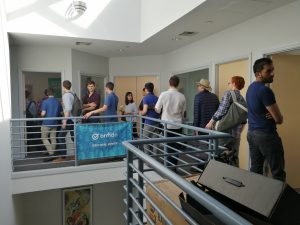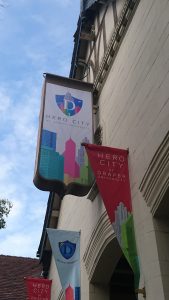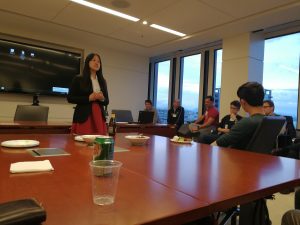This is the second part of my blog post recounting my Silicon Valley trip. You can find the first part here.
Onfido
This is a still relatively early stage startup founded by a former president of Oxford Entrepreneurs. They’re solving a real problem, which is that the whole process of getting a background check is terrible. Onfido is used by lots of tech companies who are in the sharing economy such as Uber, Deliveroo, TaskRabbit, etc. as they have to check employees, ahem, sorry I mean “users”.
In true startup style, they were in some random pokey office in a dodgy area of San Francisco. We had three employees talking with us, each of whom had different stories and perspectives on startups: an Oxford alumni who’d joined Onfido as a fresh graduate just as it was getting off the ground, an Oxford MBA who’d worked in finance before transitioning to tech, and a former founder, engineer and VC who’d been around the blocks and actually discovered Onfido as an actual customer of theirs before joining when he realised they were better than what he was currently doing.
They told us the story of the company, how they operated and some of its nuances (their cultural values are represented by animals, how quirky!). My main takeaways were:
That you don’t even need a minimum viable product (MVP) just a “MP” to start selling. When the company first started they were manually doing the work. The clever machine learning part only came later once they got customers. This reiterated the “every startup is a shit show on the inside”. The important thing is if you’re going to sell a product you haven’t actually built yet, to pull it off you need to be able to do it manually whilst building the actual thing.
The message “you’re as good as your network” was iterated. Doing a startup is so unpredictable that you need to know people who can help and be unafraid to ask for help. Also it’s the only way to get funding. Despite being the centre of the internet, so much of behind the scenes of the tech world operates by word of mouth and person-to-person meetings (everyone looks great on the outside; everyone is a complete mess on the inside).
Minerva Schools
Minerva is basically a startup trying to disrupt prestigious higher education. Its founder, the former president of Snapfish (physical photos, remember them?), Ben Nelson started our tour by asking us what we would teach the 18 year olds that would go on to become the most powerful people in the world if we knew who they were in advance. Our answers were pretty predictable: logic, statistics, ethics, management, systemic thinking, public speaking, etc. He then pointed out that none of the top universities, who are currently teaching the vast majority of the future world leaders, actually teach all of these skills as part of their courses.
Minerva’s pitch is that the traditional model of higher education is no longer suitable for our modern world. There hasn’t been a new elite university in the states for a century so it’s time for some fresh blood to rethink university education from the ground up. It’s ridiculous to pay thousands of dollars for someone to stand up and read books to you when content is basically free on the internet now. The world is changing at such a fast pace these days that it makes no sense to spend 3-5 years learning just one topic that’ll be out of date within a decade or so. Instead we need to focus on transferable skills and teaching how to think and reason well as well as be able to apply it in any context.
Minerva works much like a normal American university but, in typical Silicon Valley fashion, it “does things a little different”. Students do a four year undergraduate degree where they can specialise in social sciences, computational sciences, natural sciences, arts and humanities, or business. They also offer master’s degrees. They have no classrooms however as students learn using Minerva’s “active learning platform”. A lot of their courses are self-taught and use external material such as from Coursera. This requires far less staff and overhead.
The big difference though is that in the first year the programme is constructed just around ‘habits of mind’ and ‘ foundational concepts’ (and when to apply them) that apply across academic fields. These are things like counterfactual thinking, classical rhetoric techniques, the scientific method, correlation does not imply causation, etc. The idea is to teach really solid ways of thinking and then apply them over and over again in loads of contexts. They claim the approach is based on a whole bunch of pedagogical science so is proven to be far more effective.
Ben Nelson’s argument goes that students at top universities learn how to solve particular problems but then don’t know how to apply what they’ve learnt in new contexts. The concept of doing this is called ‘far transfer’, applying ways of thinking to completely distant contexts. As an example: when a doctor prescribes medication they’ll ask about any other medication you may be taking in order to avoid any negative consequences of the two medications interacting. However, that very same doctor when thinking about new healthcare legislation won’t think about how the new law will interact with existing laws. Basically they’re trying to actively teach what’s commonly known as “wisdom”.
There’s a bunch of other shiny aspects of the university such as campuses around the world that students will have to spend time in in order to foster a global outlook. There are also some famous names associated with the school such as Larry Summers, and they have connections with impressive companies that offer great internship opportunities. Minerva also claims to have the best of the best students since they have the most selective undergraduate programme in US history.
I think the idea of spending some time deliberately teaching general concepts and good ways of thinking is great. Most top students learn this stuff on the side just by being curious and at university, but putting more emphasis on this stuff and making sure all students learn it could be really valuable. There are some courses that kind of already do it, such as PPE, but I feel it is missing from the narrowly focused UK university courses. It’s also much better to learn actively rather than passively and use technology to individualise learning. Plus any school that can offer students non-extortionately priced tuition has to be a good thing. This is where the ‘but’ comes in.
Minerva is doing things a little different, and hopefully a little better, but Ben Nelson portrayed it like it was a truly revolutionary education. He claimed they offer students a metaphoric Tesla compared to other universities’ 1970s Cadillac. Minerva has a “positive” brand whereas every other university has either a “neutral” brand, such as Oxford, or a negative one, e.g. a former polytechnic (not naming any names). Their students are apparently a whole league above every other’s in ability, based on some selective anecdotes. It might be just my British sensibilities clashing with Silicon Valley aggrandising, or self-defence of my own traditional education, but it felt to me like a solid idea coated in unnecessary bullshit. It didn’t help how defensive Nelson got when a room full of Oxford students started questioning his grand claims.
But hey, Minerva has raised over $70m dollars from major investors and the American higher education system is clearly in need of a shake up so maybe I’m unfairly sceptical. The first cohort will graduate in 2018 so it’s too early to judge whether Minerva really has disrupted the university.
Draper University of Heroes
The following morning we visited Draper University, the eponymous school founded by billionaire VC Tim Draper. This school, which is not accredited, teaches short courses in entrepreneurship and business. It is very Silicon Valley, by which I mean it’s bold and platitudinous almost to the point of being detached from reality. This stems from its superhero theme. Wannabe entrepreneurs are ‘heroes’ (because getting people to give you money is equivalent to saving lives I guess).
They like “to do things a little different here”. The school is in a converted hotel, with brightly coloured walls either covered in giant cartoon superheroes or whiteboards for writing ideas and misspelt inspirational quotes. Classes sometimes spontaneously jump in the swimming pool mid-lecture. Its reception desk is a recycled Tesla for crying out loud.
It initially felt almost like a Trump University-like con; dupe naive optimists into spending far too much money on common sense covered in pseudo-inspirational nonsense they think will make them rich. So I was pleasantly surprised to find my British ‘realist’ scepticism proven wrong. One of the university staff gave us a really good workshop on pitching, where we taught and got to practise the basic principles of pitching a startup to potential investors. This is what I learnt.
Good pitching is all about making it easy to catch. That means keeping it simple stupid. We saw AirBnB’s pitch deck and it only has a few lines and some diagrams, super basic. Draper recommends the following pitch structure:
- Story – Hook the listeners in with an emotive and personal story.
- Problem – Needs to be a real problem that is worth solving and YOU are the person to solve it.
- Solution – How does your product work? What technology does it use (overall technology not stack specific, e.g. machine learning not Microsoft)?
- Product – Short demo of actual product or screenshots/images. Can use a service called Prott to make a “working” app.
- Market – Size of market, percentage you’ll penetrate, trends etc. Can use Facebook ads for market research as they tell you the number of users that meet such and such demographics. LinkedIn is good for B2B market research as well.
- Traction – How many users/letters of intent/signups/strategic partners do you have already? A list of email addresses you’ve collected could be enough.
- Competitive landscape – Who are you competing against and what makes you different from them
- Market strategy – How will you capture your market? Cost of acquisition, revenue model, pricing structure, how does investor make money, 5-year projection.
- Team – This is the most important slide since the product can adjust far easier than the team can. Investors are making a bet on YOU more than the business. Why are you awesome? Why can you pull this off? What is your co-found relationship?
- Ask – Why are you pitching? What do you want from the listeners? Money, partners, team members, connections, customers?
e.ventures
Our next meeting was slightly different from the others as it was at a venture capital firm. e.ventures is different from most VCs in the valley as they’re originally European. This gives them a more global outlook with offices around the world. Their San Fran offices are near the top of the iconic Transamerica Pyramid. They have an entire floor but since they’re near the peak the whole space is actually quite small. It does have astonishing views though, and they know it.
Once we’d torn ourselves away from the vista one of the partners explained how a VC firm, and specifically e.ventures, operates. I can’t go into too much detail though since we were sworn to secrecy. Being a venture capitalist is similar to drilling for oil. You spend most of your time surveying the lie of the land trying to spot the place to actually drill. Once you find it you throw your resources at it but it takes a while before you actually get any returns, however when/if you do make money eventually it’s many multiples of your original investment. e.ventures only makes around 5-8 investments per year and have backed some of the big names and unicorns in SV.
Most investors in a VC fund are long-term institutional investors such as pension funds and endowments who have long time frames and are seeking diversification. Their money is tied up for a decade but the returns shouldn’t be that correlated with the general stock market. My back of the napkin calculation was that their annual net returns are something in the region of 8%, which was less than I’d assumed. This is due to the all or nothing nature of the investments and the time taken to exit.
e.ventures uses some clever tech to do their surveying, spot potential, and track market and tech trends. This allows them to drastically reduce the top of the funnel so the humans only need to look at small subset that have a higher chance of being worthy of investment.
Oxford Entrepreneurs of the Bay
That evening we joined the monthly meeting of Oxford Entrepreneurs of the Bay, an Oxford alumni network of entrepreneurs, mentors and investors who meet to share their ventures. They’ve also set up an angel fund to back startups with an Oxford affiliation.
The evening consisted of meeting a whole load of interesting people and hearing about their jobs and companies. It was interesting because you could definitely tell the Oxford influence combined with the Silicon Valley culture in the people we met.
There were also two actual pitches for startups. This was interesting after learning just that morning about pitching and spotting the techniques used (or not used). There were two sides to these pitches as there were genuine investors in the room (some of whom actually invested I believe) but also it was seen as a chance to practice the pitch in front of a friendly audience. Some of the audience questions were incredibly insightful and helped the pitchers refine their thinking as well as their presentations.
One of the two proposed startups was particularly interesting as it was a prayer app. The official spokesmen of the Vatican had made a speech at SXSW calling for tech to serve the religious and one of the listeners had heeded the call. This tied into another theme I picked up during the trip, which was a shift away from creating products serving western, educated, middle class geeks to wider markets. This is probably just economics as smart phone usage spreads and becomes pervasive, whilst the western markets become saturated (like do we need yet another dating or delivery app?). Expect to see more unexpected apps and services over the coming years.
School 42
Another approach to disrupting education is being undertaken by School 42. Founded by the French tech billionaire Xavier Niel, it’s a private, tuition-free, vocational programming school. Xavier saw that the current education system was producing too few high quality programmers and that those spat out by top universities may have excellent academics but had poor practical software development skills. He also felt that by requiring a CS degree companies were excluding talent from less conventional sources and underrepresented groups in the tech world, such as ethnic minorities from poor backgrounds. We visited the school’s new, exceptionally cool looking California campus.
The school, aptly named for the meaning of life from Hitchhiker’s Guide, takes a very pragmatic and lean approach to teaching. The curriculum is built around projects. Starting from the very foundations of programming (students must build their own version of the standard C library from scratch), students work through a web of coding tasks. For each project they build a solution, which is submitted for automatic then peer review to confirm the solution fulfils the specifications and the code quality is up to scratch. The coding standards are exacting. If unsuccessful, students can go away, make corrections and resubmit. Once successful they can move onto the next connected project, much like passing levels/worlds in a video game.
In fact, the whole education process is gamified. All the project resources and marking as well as the student’s progress are run through the school’s web platform, much like a far more integrated Code Academy. Students gain levels and points. They can also win bonus prizes for helping fellow students and the like.
Thanks to the online platform, the school is nearly entirely student run. There are no professors, the students teach themselves using online resources and work together to find out how to do stuff. This is just officially recognising how most technical students actually operate/plagiarise and reflects how people learn and solve problems in the “real-world”. The students also organise all their own social events and sports, entirely in charge of the none-academic side of the school.
The entire program takes around three to four years. One of the beauties of the programme is students can do it at entirely their own pace. The school is open 24/7 allowing students to follow any sleep-cycle they like and stay up all night (or day) coding if they wish. They submit each project when they feel it is ready and can work on as many as they like that they’ve unlocked. There are no project time limits or deadlines. They can also go back and resubmit previous projects to get a better score or 100% completion. This means wunderkinds can race through it but also people who have other commitments such as family or job can also do it on the side.
Once a student has completed certain projects and reached a required level they have to undertake an internship. Thanks to the school’s support from tech idols these internships are often with prestigious firms. The school is entirely built around getting the students actual software development jobs. If the student gets offered a job before completing the course, or decides to launch a startup, they are actively encouraged to dropout early. They are free to return later to complete their course if they wish.
Currently the whole programme is completely free and requires no formal commitment. This is due to the generosity of Niel and other sponsors which mean the school is fully funded for ten years. This is an incredible deal for the students, especially in the states where tuition fees are astronomical. In fact it’s such a good deal the school is struggling to entice applicants from deprived areas as they can’t believe there’s not a catch.
On top of this, the programme is open to anyone aged between 18-30. It has no qualification requirements and doesn’t require any coding knowledge or experience. Applicants must complete an online logical reasoning test that checks they are skilled at the kind of thinking coding requires. If selected they must then survive the brutal initial bootcamp, the “piscine”. This is the SAS initiation of programming, requiring students to either sink or swim, as the name alludes to.
During our visit, after an initial talk by one of the administrators we were, naturally, shown around by the students. We saw some of their projects, which were very impressive considering they’d been built entirely from the ground up (such as an entire 3D graphics engine!). The students we met mostly had degrees already, although one had turned down CS at Harvard to join the school. Quite a few were foreign, taking advantage of only requiring a tourist visa to take part since the school isn’t an official education institution and doesn’t issue qualifications. The staff impressed on us however that they were reaching out to schools in the more deprived parts of the Bay Area so that later cohorts would be even more diverse and inclusive.
I was very impressed by the school and looking at the student’s work it certainly seems to work well. We agreed that this approach doesn’t replace the university model, since there is real value in the academic theory and only half of the university experience is the official teaching. It does however fill a vacancy for vocational training, allowing smart young people who’ve maybe performed poorly in exams and aren’t able to attend university, or don’t wish to, get a high quality tech job.
The current funding model isn’t sustainable of course, unless they can find another billionaire to step up. However, thanks to their lean approach it actually costs the same to put a student through the whole programme (excluding living costs) as Google spends on recruitment per graduate. If they maintain the high calibre of their “graduate”, I don’t think the school will find it hard at all to convince top tech companies to sponsor them for access to their top talent.
Read more in Part III.






